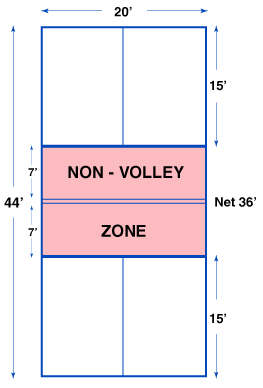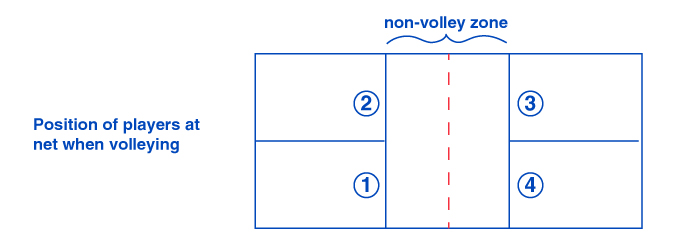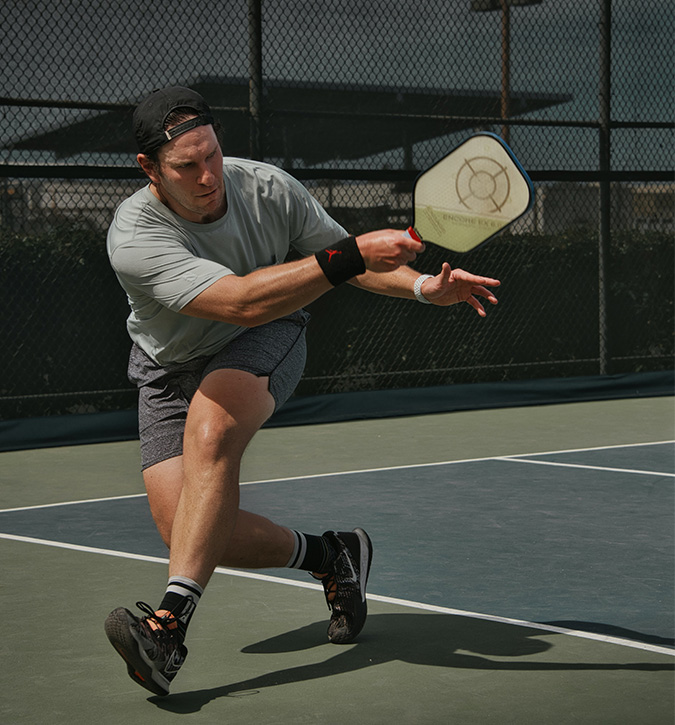Pickleball
A lively racket game for all ages and abilities. Pickleball was created with one thing in mind: fun! It was designed to be easy to play whether you are five, eighty five or somewhere in between.
Fun, social and friendly. The rules are simple and the game is easy for beginners to learn, but can develop into a quick, fast-paced, competitive game for experienced players.
The Basics
• A fun sport combining many elements of tennis, badminton and ping pong.
• Played both indoors and outdoors on a badminton sized court and slightly modified tennis net.
• Played with a paddle and a plastic ball with holes
• Played in doubles or singles
• Can be enjoyed by all ages and skill levels
Brief History of Pickleball
Pickleball is a game for the whole family. So, it is only fitting that it was invented by a family, too. The game was invented in 1965, in Bainbridge Island, just a short ferry ride away from Seattle, Washington. When Congressmen Joel Pritchard, William Bell and Barney McCallum came home from a game of golf one day to find their kids bored and restless, they set out to create a game that would engage them through the lazy days of summer.
They wanted to create a game that would be challenging, but still accessible. They handed the kids table tennis paddles and a wiffle ball (a baseball sized plastic ball with holes), and lowered the net on their badminton court. In the coming days both kids and adults alike fell in love with the game, and as they played, the rules evolved (to include the non-volley zone, for instance) and solidified to their present status.
Today, Pickleball is played all over the world through community groups, PE classes, YMCA, retirement communities and much more. According to a recent article, there are more than 2 million people playing Pickleball in the US alone, while the game is growing exponentially and expanding to other regions in the world.
Evolution of the Pickleball Paddle
What started out as a backyard game relying on random gear from other racket games like badminton and ping-pong, quickly evolved and came into its own. In the early days, the founders of Pickleball soon discarded ping-pong paddles, and began creating their own rackets using wood and a jigsaw.
Paddles like the one above had what we call "first generation" improvements including a reinforced rounded grip that made the paddle stronger, and more comfortable.
In an effort to create an even better paddle, the founders of the game began experimenting with different materials. They began acquiring scrap aerospace honeycomb materials, which were not only light but exceptionally durable. Here is an example of early honeycomb panel material used in paddle design and construction.
As Pickleball has grown, so has the demand for paddles made of high-tech materials. Now, instead of taking the scraps from big aerospace companies, Pickleball Inc. is able to custom-order the most advanced materials specifically for Pickleball paddles.
How to Play Pickleball
Basic Overview
Pickleball is played on a badminton-sized court: 20’ x 44.’ The ball is served diagonally (starting with the right-hand service-square), and points can only be scored by the side that serves.
Players on each side must let the ball bounce once before volleys are allowed, and there is a seven-foot no-volley zone on each side of the net, to prevent “spiking.” The server continues to serve, alternating service courts, until he or she faults. The first side scoring eleven points and leading by at least two points wins. Pickleball can be played with singles or doubles.

The Pickleball Serve
Serves are to be made diagonally, starting with the right-hand service-square and alternating each serve. The serve must clear the seven-foot non-volley-zone in front of the net and land in the diagonal service court.
The Server must keep both feet behind the back line when serving. The service is made underhand with the paddle contacting the ball below the waist. The Server must hit the ball in the air on the serve. The Server is NOT allowed to bounce the ball and hit it off the bounce. The service is made diagonally cross court and must clear the non-volley zone, including the line (A serve that hits the non-volley zone line is out) Only one serve attempt is allowed, except if the ball touches the net on the serve and lands in the proper service court, in this case the serve may be taken over. At the start of each new game, the 1st serving team is allowed only one fault before giving up the ball to the opponents. Thereafter both members of each team will serve and fault before the ball is turned over to the opposing team. When the receiving team wins the serve, the player in the right hand court will always start play.
Volleys
To volley means to hit a ball in the air without first letting it bounce. In Pickleball, this can only be done when the player’s feet are behind the non-volley zone line (seven feet behind the net). Note: It is a fault if the player steps over the line on his volley follow-through
Double- Bounce Rule
Also called the Two Bounce Rule, each team must play their first shot off of the bounce. That is, the receiving team must let the serve bounce and the serving team must let the return of the serve bounce before playing it. Once these two bounces have occurred, the ball can either be volleyed or be played off the bounce.








